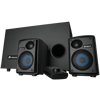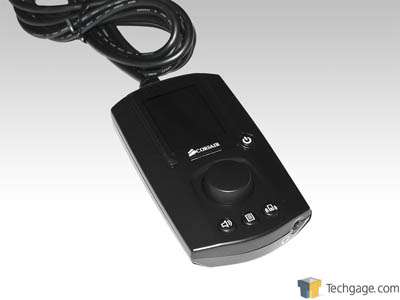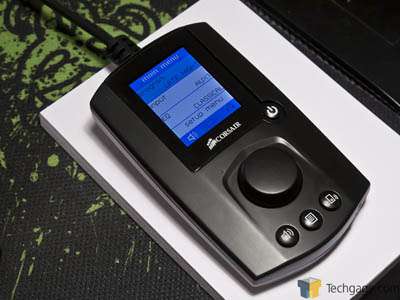- Qualcomm Launches Snapdragon 4 Gen 2 Mobile Platform
- AMD Launches Ryzen PRO 7000 Series Mobile & Desktop Platform
- Intel Launches Sleek Single-Slot Arc Pro A60 Workstation Graphics Card
- NVIDIA Announces Latest Ada Lovelace Additions: GeForce RTX 4060 Ti & RTX 4060
- Maxon Redshift With AMD Radeon GPU Rendering Support Now Available
Corsair SP2500 2.1 Gaming Speakers Review

With the launch of its HS1 headset last fall, Corsair proved that the audio market wasn’t one it was planning on jumping into without first making sure that its products would impress. But what about those gamers that don’t like to use headphones? The answer is the SP2500, a speaker set with a unique design, and a lot of power.
Page 2 – Control Unit
The control unit is of the wired variety that connects to the back of the subwoofer via a 15-pin VGA connector. This unit controls master and sub volume, equalization modes and various sound profiles, as well as selecting input options.
It has two 3.5mm jacks, one on top as AUX 2 input, easy reach for something like an iPod; the second jack on the base is for connecting headphones. The anomaly would be the inclusion of a currently superfluous micro-USB port, to which Corsair states as being for possible future firmware upgrades.
This in itself is very intriguing and something I wish were included with other speaker sets, namely those with DSP units – as there can often be minor annoyances or bugs that can be fixed via firmware updates. In the case of the SP2500’s, that list would be small, but we’ll touch on that later.
Selecting all these features through a small and limiting LCD display would not be ideal, so Corsair were kind enough to provide a 1.8 inch TFT display – a real rarity with PC speakers.
There are four backlit buttons and a digital dial for menu selections.
When powered on, it’s very discrete with a small white light under the master volume button – no garish brilliant blue LED’s that never quite reached laser level here. Pushing any buttons or turning the dial will illuminate the backlight.
The bottom 3 buttons, from left to right are Master Volume, Menu and Subwoofer Volume. The main dial will always default to volume control when left idle for a while, pushing the dial as a button enables muting – both on volume and sub. There is a small problem with the screen, that of limited viewing angles. For the most part, you can navigate settings blind, but the option menu does require you to look at the screen.
The dial has a small amount of feedback when rotating, but as a button, it is rather stiff. It can be a little awkward when it comes to sensitivity, not every felt rotation click will result in an action, usually every 2-3. This is minor though, since it otherwise performs flawlessly.
Due to the nature of the speakers being largely digital in nature (makes use of digital crossovers and a DSP for EQ and environment settings), even volume control is digital. This can prove to be a bit of a nuisance as volume control works in steps – 24 in total. These are linear in progression and as a result, the difference between 2 settings can be stark, with no other way to fine tune the volume without using your PC’s system volume control. If more volume settings were made available, 30 for example, it would make dialing in a specific level easier, without having too quiet or too loud. That upgradable firmware sounds like a good idea now.
Support our efforts! With ad revenue at an all-time low for written websites, we're relying more than ever on reader support to help us continue putting so much effort into this type of content. You can support us by becoming a Patron, or by using our Amazon shopping affiliate links listed through our articles. Thanks for your support!







